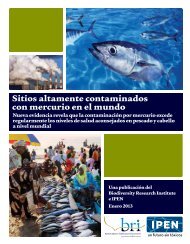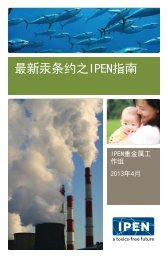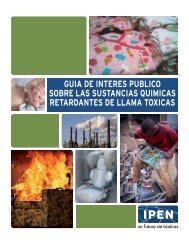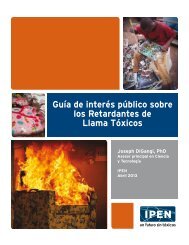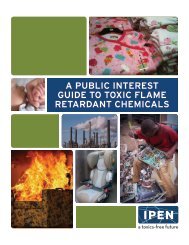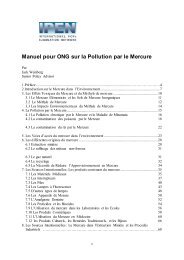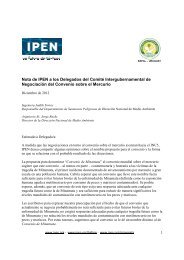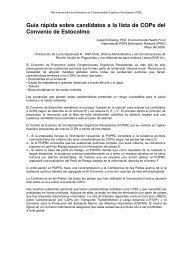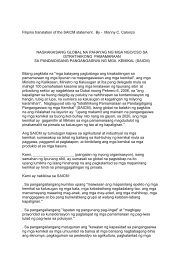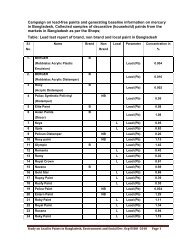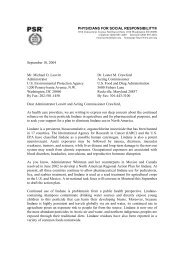The UNDP-GEF POPs Resource Kit - International POPs Elimination ...
The UNDP-GEF POPs Resource Kit - International POPs Elimination ...
The UNDP-GEF POPs Resource Kit - International POPs Elimination ...
Create successful ePaper yourself
Turn your PDF publications into a flip-book with our unique Google optimized e-Paper software.
eliminate <strong>POPs</strong> and the problems they cause. Many in developing countries welcomed the<br />
Stockholm Convention as a vehicle that helps raise awareness at home, and that helps<br />
mobilize the resources needed to take meaningful action to manage and eliminate harmful<br />
chemical pollutants.<br />
During negotiations on the treaty, developing countries and countries in transition<br />
sought provisions that not only address global concerns, but also ones that address domestic<br />
needs and concerns. This was largely successful. <strong>The</strong> Stockholm Convention Preamble<br />
mentions local exposures to <strong>POPs</strong> as an important health concern of developing countries.<br />
This precedes any reference in the treaty to long-range transport.<br />
<strong>The</strong> Convention explicitly acknowledges, at the insistence of many developing<br />
country governments, that: “sustainable economic and social development and eradication of<br />
poverty are the first and overriding priorities of the developing country Parties.”<br />
Governments indicated support for Convention objectives and measures, but many also<br />
clearly indicated they have limited resources and they have other, higher priorities. <strong>The</strong>se<br />
governments did not wish to sacrifice resources dedicated to their higher priority interests in<br />
order to meet Stockholm Convention objectives. To reflect this concern, the Convention<br />
states:<br />
“<strong>The</strong> developed country Parties shall provide new and additional financial<br />
resources to enable developing country Parties and Parties with economies in<br />
transition to meet the agreed full incremental costs of implementing measures<br />
which fulfill their obligations under this Convention …”<br />
<strong>The</strong> Stockholm Convention links effective implementation of Convention<br />
commitments on the part of developing country Parties to the performance of donor<br />
governments in meeting their Convention commitments to provide financial resources,<br />
technical assistance and technology transfer. This provides a framework for mobilizing<br />
assistance and for building awareness. Many who work in Health Ministries, Environment<br />
Ministries, Agriculture Ministries, and others, and who have responsibilities for government<br />
activities to protect public health and the environment from toxic chemical pollutants<br />
welcome the Convention and the opportunities it can help provide.<br />
E. <strong>POPs</strong> Sources and Convention Provisions<br />
Of the initial twelve <strong>POPs</strong> covered under the Stockholm Convention some have been<br />
used as pesticides, some as industrial chemicals and some arise as unwanted byproducts of<br />
chemical and combustion processes.<br />
<strong>The</strong>se different categories overlap. For example, Mirex, which was produced<br />
primarily for use as a pesticide has also been used as a fire retardant; PCBs, which were<br />
produced as industrial chemicals in large quantities, are also generated as unwanted<br />
10 ----------------------------------------------------------------------------------------<strong>UNDP</strong>-<strong>GEF</strong> <strong>POPs</strong> <strong>Resource</strong> <strong>Kit</strong>



